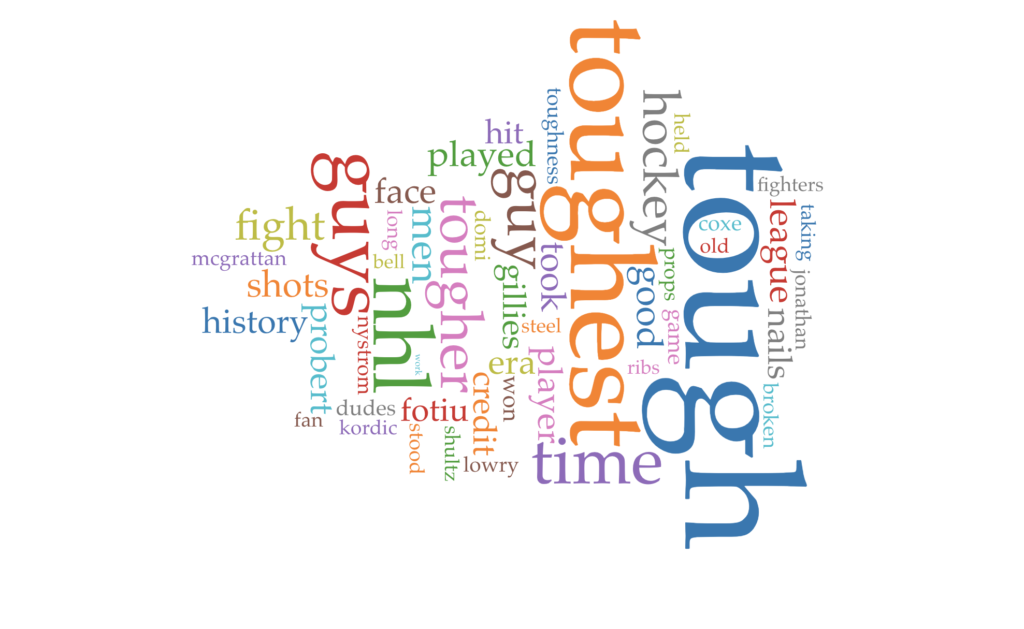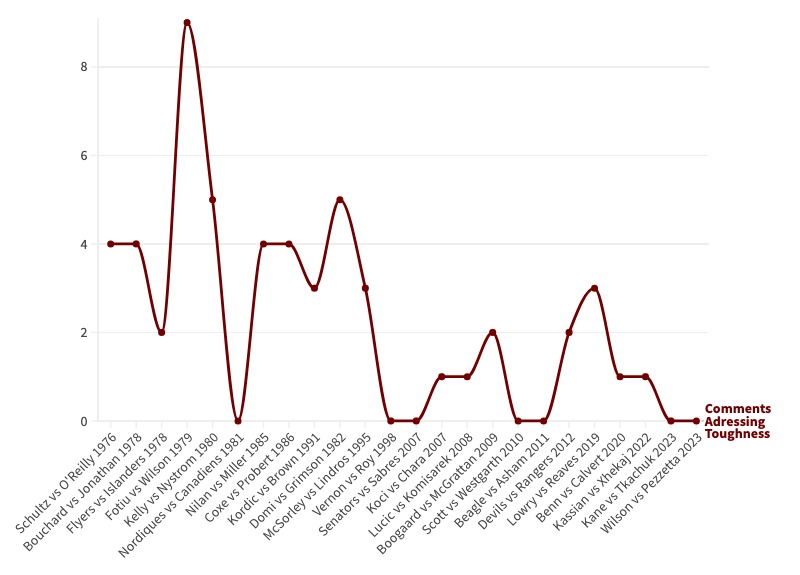Throughout hockey’s history toughness is a trait that has been valued highly within the surrounding community of fans and viewers. Because of the presence of violence and physicality in hockey, toughness is something that is almost necessary in order to succeed in playing the sport. At higher levels it is common to see players play through injuries, something sports media never fails to emphasize. For example, earlier in 2024, New York Rangers Defenseman Ryan Lindgren left a game after taking a stick to the face. The injury required 10 stitches, leaving his eye and the surrounding area bruised and swollen, but this did not stop him from returning to the ice in the team’s next game less than 48 hours later. He was applauded and praised by hockey fans as well as fans of other sports with the largest sports media company in the world, ESPN, posting about it.
With this example and many others it is no surprise that toughness is the most significant form of masculinizing discourse within data analysis. The theme appeared in 2.375 comments per video and came up in 15 % of the 360 comments. This idea of toughness was evident in many different ways but often appeared with commenters directly addressing toughness of players involved. This can be seen within the comments of the Nick Fotiu vs Behn Wilson fight in 1979, Fotiu is the player in blue and Wilson in white. Here both comments and a brief analysis of them are tagged and we can see the comments play out within the context of the fight:
Nick Fotiu vs Behn Wilson Apr 1, 1979, Hockeyfights.com, Dec 2009
Another comment on the fight reads, “Nick Fotiu was probably one of the toughest players in the history of the game…This guy was not just tough he was actually scary tough.”(“Nick Fotiu vs Behn Wilson Apr 1, 1979” 2009). Not only was the commenter admiring the toughness of Fotiu within this specific fight, but also the toughness demonstrated throughout his entire career. The commenter also noted that Fotiu was “scary tough”, implying the fear both he and his toughness instilled among other players.
Using voyant, some of the most frequently used phrases in comments adressing toughness were identified:

While in the previous example the commenter used the word tough, there are other cases where toughness can be seen without the word’s use. In the 1996 fight between Tie Domi and Stu Grimson, one comment reads, “Domi had the hardest head in NHL history. He was never hurt once”(“Tie Domi vs Stu Grimson Feb 22, 1996” 2009). Within this fight Domi is able to handle a lot of punches thrown by Grimson. Though the term “hardheaded” is often used to describe a person as practical or realistic, this commenter seems to have meant it more literally, using it to reference Domi’s ability to take a punch and avoid injury both of which imply his toughness.
When taking a more in depth look into the quantitative findings about toughness it was evident that it was less present in the comments on more recent fights. Seventy-seven percent of the 57 times toughness was identified were in videos from the first three decades, the 70’s, 80’s and 90’s; only 23% of comments addressing toughness were among more recent fights, from the 00’s, 10’s and 20’s. This implies commenters perceive players to be less tough in the last 20 years of NHL fights. This trend is supported by a comment from one of the earlier fights between Dave Schultz and Terry O’Reilly in 1976, “when men played hockey, tough men”(“Dave Schultz vs Terry O’Reilly Jan 25, 1976” 2013). While the comment addresses the toughness that was apparent within this fight, it also implies there are no longer any “tough men” playing today. Not only is less toughness today implied by the quantitative data, but it is referenced quite literally in the comments themselves.
The data is able to show that toughness is the most present form of masculinizing discourse, yet it also shows that this form of masculinizing discourse is declining. In a chart portraying the number of comments addressing toughness in each fight analyzed this is even more clear:

Clearly toughness is a trait that is still valued among the hockey community of fans and viewers, as many of the comments note disappointment with the lack of toughness and tough men. This trend is not dissimilar to what is happening throughout society today, with older generations critiquing younger ones. It’s actually done in a particularly similar way, in both situations the newer generation is being labeled as “soft” by older ones. This is all in comparison to older generations’ own experiences or their contemporary, perhaps nostalgic, imaginations of their own youth.